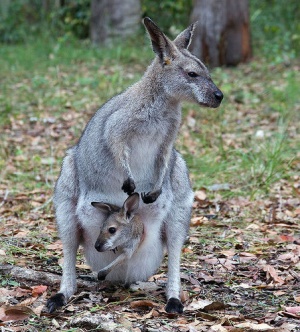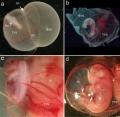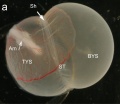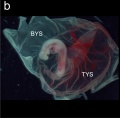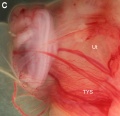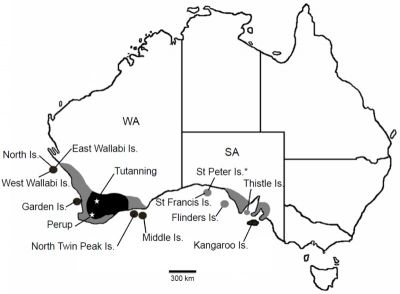Kangaroo Development
| Embryology - 27 Apr 2024 |
|---|
| Google Translate - select your language from the list shown below (this will open a new external page) |
|
العربية | català | 中文 | 中國傳統的 | français | Deutsche | עִברִית | हिंदी | bahasa Indonesia | italiano | 日本語 | 한국어 | မြန်မာ | Pilipino | Polskie | português | ਪੰਜਾਬੀ ਦੇ | Română | русский | Español | Swahili | Svensk | ไทย | Türkçe | اردو | ייִדיש | Tiếng Việt These external translations are automated and may not be accurate. (More? About Translations) |
Introduction
Macropodid marsupial have short five digit forelimbs and large four digit hindlimbs specially adapted for hopping. The hindlimb digits differ from mammals by a missing digit 1, fused digits 2 and 3 and an elongated digit 4.
- tammar wallaby (Macropus eugenii)
| Australian Animal: echidna | kangaroo | koala | platypus | possum | Category:Echidna | Category:Kangaroo | Category:Koala | Category:Platypus | Category:Possum | Category:Marsupial | Category:Monotreme | Development Timetable | K12 | |||||
|
| ||||
| Animal Development: axolotl | bat | cat | chicken | cow | dog | dolphin | echidna | fly | frog | goat | grasshopper | guinea pig | hamster | horse | kangaroo | koala | lizard | medaka | mouse | opossum | pig | platypus | rabbit | rat | salamander | sea squirt | sea urchin | sheep | worm | zebrafish | life cycles | development timetable | development models | K12 |
Some Recent Findings
|
| More recent papers |
|---|
|
This table allows an automated computer search of the external PubMed database using the listed "Search term" text link.
More? References | Discussion Page | Journal Searches | 2019 References | 2020 References Search term: Kangaroo Embryology | Wallaby Embryology |
| Older papers |
|---|
| These papers originally appeared in the Some Recent Findings table, but as that list grew in length have now been shuffled down to this collapsible table.
See also the Discussion Page for other references listed by year and References on this current page.
|
Taxon
Taxonomy ID: 9322
Genbank common name: kangaroo
Inherited blast name: marsupials
Rank: species
Genetic code: Translation table 1 (Standard)
Mitochondrial genetic code: Translation table 2 (Vertebrate Mitochondrial)
Lineage ( full )
cellular organisms; Eukaryota; Opisthokonta; Metazoa; Eumetazoa; Bilateria; Coelomata; Deuterostomia; Chordata; Craniata; Vertebrata; Gnathostomata; Teleostomi; Euteleostomi; Sarcopterygii; Tetrapoda; Amniota; Mammalia; Theria; Metatheria; Diprotodontia; Macropodidae; Macropus
- Links: Taxonomy Browser Macropus
Development Overview
- short pregnancy period (tammar wallaby 26.5 days)
- pregnancy can be maternally delayed (diapause) at blastocyst stage
- born in altricial (underdeveloped) state
- development continues attached to a teat in the pouch
- during pouch period growth controlled by milk composition changes
- immune system, thyroid and thermoregulation develops after birth
Tammar Wallaby
The following tammar wallaby (Notamacropus eugenii) embryo images are from a paper on placental evolution.[4]
Tammar Wallaby Limb Development[5]
The development of tammar fetal limbs at selected stages before birth. (A) day 19, (B) day 20, (C) day 22, (D) day 24 and (E) day 25 (one day before birth).
- Tammar Limbs: day 19-25 | day 19 | day 20 | day 22 | day 24 | day 25 | Limb Development | Kangaroo Development
Former and current distribution of the tammar wallaby (Notamacropus eugenii) in Southern Australia.[6]
Genome
The tammar wallaby karyotype (2 n = 16) consists of 7 autosomes and the two sex chromosomes.[7]
Gonad Development
The following data is from the tammar wallaby (Macropus eugenii) study.[8]
Female ovary
- migrate caudally between days 10 and 20 after birth.
- gubernaculum differentiates into:
- round ligament in the abdomen
- extra-abdominally as the ilio-marsupialis muscle of the mammary glands.
Male testis
- migrate to the internal inguinal ring by day 20 post partum (pp).
- migrate then to the scrotum between days 20 and 65 pp.
- cremaster muscle development begins day 10 pp and structure completed by day 60 pp.
- inguinal canal closed between days 50 and 60 pp.
Rock-Wallaby

Rock-wallaby Australian taxa distribution[9] |
Taxa are colored in accordance with their chromosomal groupings:
|
Mitochondrial coding genes - 12 genes, 11,373 bp.
References
- ↑ Fenelon JC, Shaw G, Frankenberg SR, Murphy BD & Renfree MB. (2017). Embryo arrest and reactivation: potential candidates controlling embryonic diapause in the tammar wallaby and mink†. Biol. Reprod. , 96, 877-894. PMID: 28379301 DOI.
- ↑ O'Hara WA, Azar WJ, Behringer RR, Renfree MB & Pask AJ. (2011). Desert hedgehog is a mammal-specific gene expressed during testicular and ovarian development in a marsupial. BMC Dev. Biol. , 11, 72. PMID: 22132805 DOI.
- ↑ Renfree MB, Papenfuss AT, Deakin JE, Lindsay J, Heider T, Belov K, Rens W, Waters PD, Pharo EA, Shaw G, Wong ES, Lefèvre CM, Nicholas KR, Kuroki Y, Wakefield MJ, Zenger KR, Wang C, Ferguson-Smith M, Nicholas FW, Hickford D, Yu H, Short KR, Siddle HV, Frankenberg SR, Chew KY, Menzies BR, Stringer JM, Suzuki S, Hore TA, Delbridge ML, Patel HR, Mohammadi A, Schneider NY, Hu Y, O'Hara W, Al Nadaf S, Wu C, Feng ZP, Cocks BG, Wang J, Flicek P, Searle SM, Fairley S, Beal K, Herrero J, Carone DM, Suzuki Y, Sugano S, Toyoda A, Sakaki Y, Kondo S, Nishida Y, Tatsumoto S, Mandiou I, Hsu A, McColl KA, Lansdell B, Weinstock G, Kuczek E, McGrath A, Wilson P, Men A, Hazar-Rethinam M, Hall A, Davis J, Wood D, Williams S, Sundaravadanam Y, Muzny DM, Jhangiani SN, Lewis LR, Morgan MB, Okwuonu GO, Ruiz SJ, Santibanez J, Nazareth L, Cree A, Fowler G, Kovar CL, Dinh HH, Joshi V, Jing C, Lara F, Thornton R, Chen L, Deng J, Liu Y, Shen JY, Song XZ, Edson J, Troon C, Thomas D, Stephens A, Yapa L, Levchenko T, Gibbs RA, Cooper DW, Speed TP, Fujiyama A, Graves JA, O'Neill RJ, Pask AJ, Forrest SM & Worley KC. (2011). Genome sequence of an Australian kangaroo, Macropus eugenii, provides insight into the evolution of mammalian reproduction and development. Genome Biol. , 12, R81. PMID: 21854559 DOI.
- ↑ Menzies BR, Pask AJ & Renfree MB. (2011). Placental expression of pituitary hormones is an ancestral feature of therian mammals. Evodevo , 2, 16. PMID: 21854600 DOI.
- ↑ Chew KY, Yu H, Pask AJ, Shaw G & Renfree MB. (2012). HOXA13 and HOXD13 expression during development of the syndactylous digits in the marsupial Macropus eugenii. BMC Dev. Biol. , 12, 2. PMID: 22235805 DOI.
- ↑ Eldridge MD, Miller EJ, Neaves LE, Zenger KR & Herbert CA. (2017). Extensive genetic differentiation detected within a model marsupial, the tammar wallaby (Notamacropus eugenii). PLoS ONE , 12, e0172777. PMID: 28257440 DOI.
- ↑ Edwards CA, Rens W, Clarke O, Mungall AJ, Hore T, Graves JA, Dunham I, Ferguson-Smith AC & Ferguson-Smith MA. (2007). The evolution of imprinting: chromosomal mapping of orthologues of mammalian imprinted domains in monotreme and marsupial mammals. BMC Evol. Biol. , 7, 157. PMID: 17822525 DOI.
- ↑ Coveney D, Shaw G, Hutson JM & Renfree MB. (2002). The development of the gubernaculum and inguinal closure in the marsupial Macropus eugenii. J. Anat. , 201, 239-56. PMID: 12363275
- ↑ Potter S, Bragg JG, Blom MPK, Deakin JE, Kirkpatrick M, Eldridge MDB and Moritz C (2017) Chromosomal Speciation in the Genomics Era: Disentangling Phylogenetic Evolution of Rock-wallabies. Front. Genet. 8:10. doi: 10.3389/fgene.2017.00010
Reviews
Renfree MB, Ager EI, Shaw G & Pask AJ. (2008). Genomic imprinting in marsupial placentation. Reproduction , 136, 523-31. PMID: 18805821 DOI.
Articles
Graves JAM. (2018). Marsupial genomics meet marsupial reproduction. Reprod. Fertil. Dev. , , . PMID: 30482268 DOI.
Fenelon JC, Shaw G, Frankenberg SR, Murphy BD & Renfree MB. (2017). Embryo arrest and reactivation: potential candidates controlling embryonic diapause in the tammar wallaby and mink†. Biol. Reprod. , 96, 877-894. PMID: 28379301 DOI.
Huyhn K, Renfree MB, Graves JA & Pask AJ. (2011). ATRX has a critical and conserved role in mammalian sexual differentiation. BMC Dev. Biol. , 11, 39. PMID: 21672208 DOI.
Chung JW, Pask AJ, Yu H & Renfree MB. (2011). Fibroblast growth factor-9 in marsupial testicular development. Sex Dev , 5, 131-40. PMID: 21540568 DOI.
McCluskey SU, Marotte LR & Ashwell KW. (2008). Development of the vestibular apparatus and central vestibular connections in a wallaby (Macropus eugenii). Brain Behav. Evol. , 71, 271-86. PMID: 18431054 DOI.
Ashwell KW, Marotte LR & Cheng G. (2008). Development of the olfactory system in a wallaby (Macropus eugenii). Brain Behav. Evol. , 71, 216-30. PMID: 18322362 DOI.
Butler CM, Shaw G, Clark J & Renfree MB. (2008). The functional development of Leydig cells in a marsupial. J. Anat. , 212, 55-66. PMID: 18069991 DOI.
Freyer C, Zeller U & Renfree MB. (2002). Ultrastructure of the placenta of the tammar wallaby, Macropus eugenii: comparison with the grey short-tailed opossum, Monodelphis domestica. J. Anat. , 201, 101-19. PMID: 12220120
Renfree MB & Tyndale-Biscoe CH. (1973). Intrauterine development after diapause in the marsupial Macropus eugenii. Dev. Biol. , 32, 28-40. PMID: 4791592
Books
- Life of Marsupials by Hugh Tyndale-Biscoe Publisher: CSIRO Publishing (2005).
- Kangaroo - A Portrait of an Extraordinary Marsupial by Stephen Jackson and Karl Vernes Publisher: Allen & Unwin (2010).
Search PubMed
Search PubMed: Kangaroo development | Macropus eugenii | marsupial development
External Links
External Links Notice - The dynamic nature of the internet may mean that some of these listed links may no longer function. If the link no longer works search the web with the link text or name. Links to any external commercial sites are provided for information purposes only and should never be considered an endorsement. UNSW Embryology is provided as an educational resource with no clinical information or commercial affiliation.
- NSW Government Information
- Newborn Baby Grey Kangaroo - Attenborough - Life of Mammals - BBC video
- Birth of the Red Kangaroo (1965) - CSIRO video 1 | video 2 video 3
- NHMRC A guide to the use of Australian native mammals in Biomedical research (1990) - PDF
Glossary Links
- Glossary: A | B | C | D | E | F | G | H | I | J | K | L | M | N | O | P | Q | R | S | T | U | V | W | X | Y | Z | Numbers | Symbols | Term Link
Cite this page: Hill, M.A. (2024, April 27) Embryology Kangaroo Development. Retrieved from https://embryology.med.unsw.edu.au/embryology/index.php/Kangaroo_Development
- © Dr Mark Hill 2024, UNSW Embryology ISBN: 978 0 7334 2609 4 - UNSW CRICOS Provider Code No. 00098G
